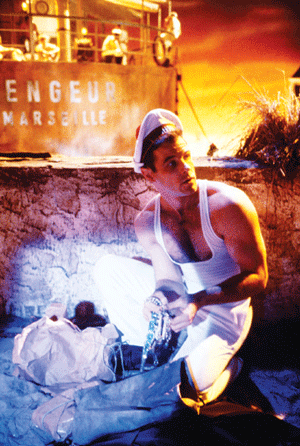Exhibitions put a new spin on the wheel (or films, paintings, cans)
BY STEPHANIE BUHMANN | AL TAYLOR: PASS THE PEAS AND CAN STUDYS This will be the gallery’s third solo presentation of the important American artist (1948-1999), who is not easily assimilated into any exclusive movement or school. It will focus on the two individual series: “Pass the Peas” (1991-92) and “Can Studys” [sic] from 1993, as well as on a related group of works entitled “Cans and Hoops” (1993). Though Taylor began his career as a painter, he embraced a unique approach to process and materials by the mid-1980s. Involving both two-dimensional drawings and three-dimensional assemblages, his work favored unconventional materials such as wooden broomsticks, wire and carpentry remnants. Making no distinction between his three-dimensional works and his drawings, Taylor referred to his constructions as “drawing in space.” In addition to physics, mathematics about depth, volume and measurement, Taylor drew inspiration from historical precedents such as the sculptures of Matisse and the time-lapse photography of Etienne-Jules Marey.
Sept. 7-Oct. 27. Reception: Sept. 7, 6-8pm. At David Zwirner, 519 W. 19th St. (btw. Tenth & Eleventh Aves.). Hours: Tues.-Sat., 10am-6pm, Mon. by appointment. Call 212-517-8677 or visit davidzwirner.com.
ANALIA SABAN
Saban, who originally hails from Buenos Aires, deconstructs paintings in order to explore their making. Along these lines, she pours acrylic into silicone molds of objects in her studio — creating sculptural paintings that play with the idea that paintings are two-dimensional representations of three-dimensional objects. In the past, she has programmed a laser cutter to remove the outlines of individual letters and images from thick white paper, running the paper through a printing press so that its contents appeared to be bleeding. Other projects have included erosion works, in which Saban’s drawings are singed onto canvas — leaving only the architecture of her original lines visible.
Sept. 6-Oct. 20. At Tanya Bonakdar Gallery (521 W. 21st St., btw. Tenth & Eleventh Aves.). Hours: Tues.-Sat., 10am-6pm. Call 212-414-4144 or visit tanyabonakdargallery.com.
LEONARDO DREW
Inspired by the cyclical nature of existence, Drew’s dynamic sculptural installations often reference the detritus of everyday life. In the past, they have involved 20,000 handmade two-inch white cotton paper boxes, open-ended wooden cubes painted black, found objects, wood and fabrics, for example. In contrast to these earlier constructions and large-scale tableaux made of geometrically organized castoff items, Drew’s new work embraces a sense of lightness and simplicity. There is an emphasis on drawing, and the installation here will be composed of many individual material elements. These will be connected through an intricate web of drawings that will be applied directly to the walls. This will be Drew’s most ambitious project to date and it will be accompanied by a comprehensive monograph.
Sept. 6-Oct. 12. At Sikkema Jenkins & Co. (530 W. 22nd St., btw. Tenth & Eleventh Aves.). Hours: Tues.-Sat., 10am-6pm. Call 212-929-2262 or visit sikkemajenkinsco.com.

QUERELLE — PHOTOGRAPHED BY ROBERT FRITZ
This will be the first New York exhibition of Fritz’s production photographs taken on the set of Rainer Werner Fassbinder’s classic and final film, “Querelle” (1982). One hundred and nineteen color images by Fritz — a photographer, producer and performer — will be on display. In the case of “Querelle,” he worked daily on Fassbinder’s set as both an actor and production documentarian. Originally shot as color transparencies, these images were previously known to exist only as “Querelle — The Film Book” (Schrimer/Mosel-Grove, 1982). Unlike film stills, which are sourced directly from filmed footage, these photographs capture re-enactments. Here, the action was re-staged for the still camera.
Sept. 7-Oct. 14. At White Columns (320 W. 13th St., enter on Horatio, btw. Hudson & Eighth Ave.). Hours: Tues.-Sat., 12-6pm. Call 212-924-4212 or visit whitecolumns.org.

ANDREW GBUR
The painter’s solo gallery debut will include two bodies of work spanning the gallery’s two LES locations. Concerned with painting’s reliability as a mode of communication, Gbur favors a highly graphic, formal and material visual vocabulary that reveals characteristics of post-war painting. Influenced by the works of Jasper Johns and Robert Rauschenberg, Gbur’s technique involves collage, silkscreen, gouache, inks and acrylic — and allows for handmade irregularity. Autobiographical and iconic imagery, ranging from self-portraits to signs and symbols, add to a dense web made of personal code. Overall, Gbur’s work reads as a complex synthesis of the demands and stresses of contemporary life. This quality crescendos in the artist’s so-called “face paintings,” in which an abbreviated language of color, material and shape depict the mere remnants of the human visage.
Through Sept. 30. Reception: Sept. 9, 6-8pm. At Eleven Rivington (195 Chrystie St. and 11 Rivington St., btw. Bowery & Chrystie). For fall gallery hours and more info, call 212-982-1930 or visit elevenrivington.com.

GINA MAGID
Born in New York City in 1969, Magid received her MFA from Pratt Institute in Brooklyn. While the subject matter of her paintings and works on paper is usually derived from popular culture, her use of form springs from her interest in the abstract layering of imagery. Striving for a feeling of transcendent beauty and mystery, Magid creates works that provide a sense of underlying psychological complexities and the connections between all things, the negative ones as well as the positive.
Sept. 5-Oct. 7. At Feature Inc. (131 Allen St., btw. Rivington & Delancey Sts.). Hours: Wed.-Sun., 12-6pm. Call 212-675-7772 or visit featureinc.com.
ALEX OLSON: PALMIST AND EDITOR
This will be Olson’s second exhibition with Lisa Cooley and the first in her new space (the former popular music venue Tonic). Olson’s paintings focus on surface appearance and treatment. She scratches, scrapes and scars her composition, pushes her materials and applies multiple layers to establish heavy impasto. This technique provides the viewer with a sense of time and of the aging of the work itself — which adds an organic, almost humane quality to an otherwise abstract vocabulary.
Sept. 9-Oct. 14. At Lisa Cooley (107 Norfolk St., btw. Rivington & Delancey Sts.). Hours: 10am-6pm,Wed.-Sun. Call 212-680-0564 or visit lisa-cooley.com.































